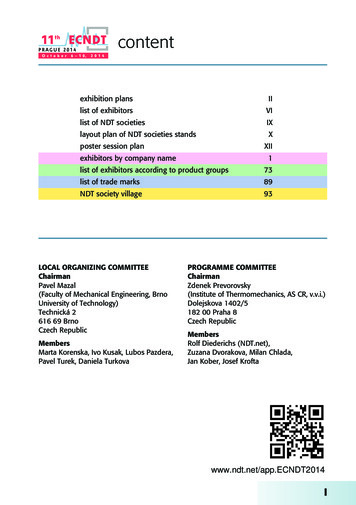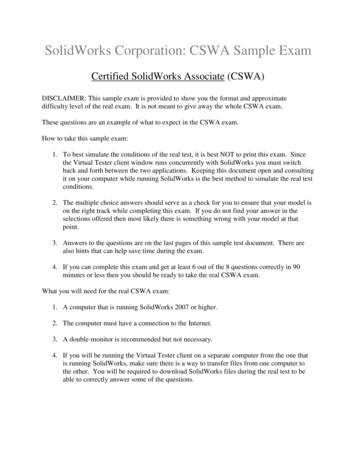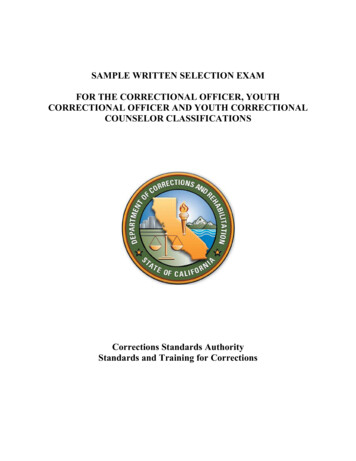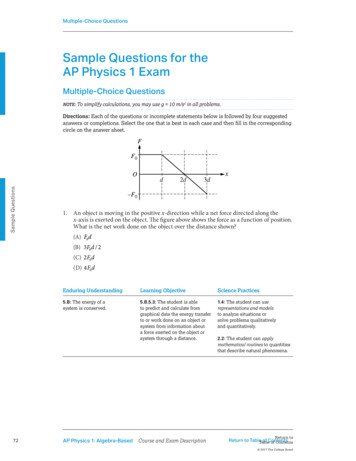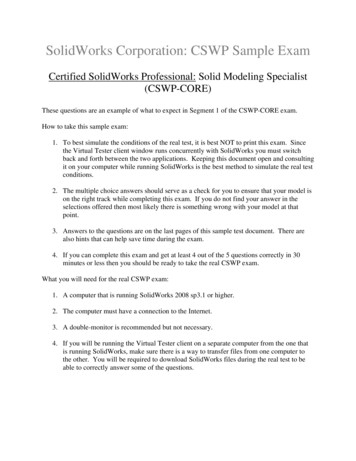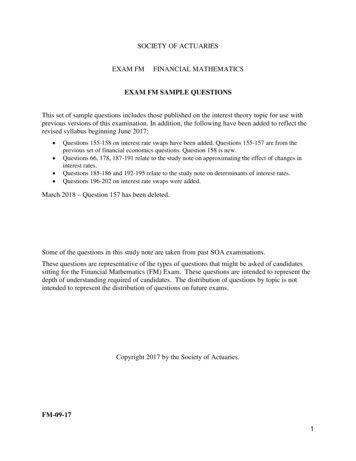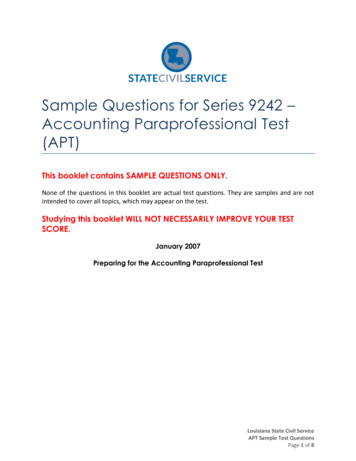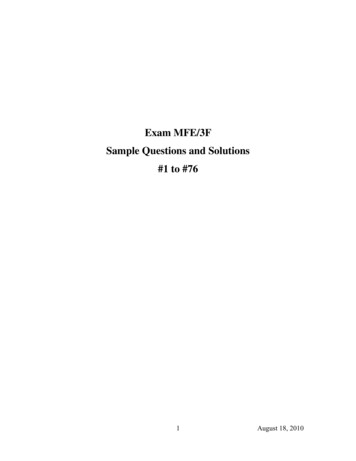
Transcription
Exam MFE/3FSample Questions and Solutions#1 to #761August 18, 2010
1. Consider a European call option and a European put option on a nondividend-payingstock. You are given:(i)The current price of the stock is 60.(ii)The call option currently sells for 0.15 more than the put option.(iii)Both the call option and put option will expire in 4 years.(iv)Both the call option and put option have a strike price of 70.Calculate the continuously compounded risk-free interest rate.(A) 0.039(B) 0.049(C) 0.059(D) 0.069(E) 0.0792August 18, 2010
Answer: (A)Solution to (1)The put-call parity formula (for a European call and a European put on a stock with thesame strike price and maturity date) isC P F0,PT ( S ) F0,PT ( K ) F0,PT ( S ) PV0,T (K) F0,PT ( S ) Ke rT S0 Ke rT,because the stock pays no dividendsWe are given that C P 0.15, S0 60, K 70 and T 4. Then, r 0.039.Remark 1: If the stock pays n dividends of fixed amounts D1, D2, , Dn at fixed times t1,t2, , tn prior to the option maturity date, T, then the put-call parity formula for Europeanput and call options isC P F0,PT ( S ) Ke rT S0 PV0,T(Div) Ke rT,n rtwhere PV0,T(Div) Di e i is the present value of all dividends up to time T. Thei 1difference, S0 PV0,T(Div), is the prepaid forward price F0P,T ( S ) .Remark 2: The put-call parity formula above does not hold for American put and calloptions. For the American case, the parity relationship becomesS0 PV0,T(Div) K C P S0 Ke rT.This result is given in Appendix 9A of McDonald (2006) but is not required for ExamMFE/3F. Nevertheless, you may want to try proving the inequalities as follows:For the first inequality, consider a portfolio consisting of a European call plus an amountof cash equal to PV0,T(Div) K.For the second inequality, consider a portfolio of an American put option plus one shareof the stock.3August 18, 2010
2.Near market closing time on a given day, you lose access to stock prices, but someEuropean call and put prices for a stock are available as follows:Strike PriceCall PricePut Price 40 11 3 50 6 8 55 3 11All six options have the same expiration date.After reviewing the information above, John tells Mary and Peter that no arbitrageopportunities can arise from these prices.Mary disagrees with John. She argues that one could use the following portfolio toobtain arbitrage profit: Long one call option with strike price 40; short three calloptions with strike price 50; lend 1; and long some calls with strike price 55.Peter also disagrees with John. He claims that the following portfolio, which isdifferent from Mary’s, can produce arbitrage profit: Long 2 calls and short 2 putswith strike price 55; long 1 call and short 1 put with strike price 40; lend 2; andshort some calls and long the same number of puts with strike price 50.Which of the following statements is true?(A) Only John is correct.(B) Only Mary is correct.(C) Only Peter is correct.(D) Both Mary and Peter are correct.(E) None of them is correct.4August 18, 2010
Answer: (D)Solution to (2)The prices are not arbitrage-free. To show that Mary’s portfolio yields arbitrage profit,we follow the analysis in Table 9.7 on page 302 of McDonald (2006).Time 0Buy 1 callStrike 40Sell 3 callsStrike 50Lend 1Buy 2 callsstrike 55TotalTime T40 ST 5050 ST 55ST – 40ST – 40ST 55ST – 40 11ST 400 1800 3(ST – 50) 3(ST – 50) 1 6erT0erT0erT0erT2(ST – 55)0erT 0erT ST – 40 0erT 2(55 ST) 0erT 0Peter’s portfolio makes arbitrage profit, because:Buy 2 calls & sells 2 putsStrike 55Buy 1 call & sell 1 putStrike 40Lend 2Sell 3 calls & buy 3 putsStrike 50TotalTime-0 cash flow 2 3 11) 16 11 3 8 23(6 8) 60Time-T cash flow2(ST 55)ST 402erT3(50 ST)2erTRemarks: Note that Mary’s portfolio has no put options. The call option prices are notarbitrage-free; they do not satisfy the convexity condition (9.17) on page 300 ofMcDonald (2006). The time-T cash flow column in Peter’s portfolio is due to the identitymax[0, S – K] max[0, K – S] S K(see also page 44).In Loss Models, the textbook for Exam C/4, max[0, ] is denoted as . It appears in thecontext of stop-loss insurance, (S – d) , with S being the claim random variable and d thedeductible. The identity above is a particular case ofx x ( x) ,which says that every number is the difference between its positive part and negativepart.5August 18, 2010
3. An insurance company sells single premium deferred annuity contracts with returnlinked to a stock index, the time-t value of one unit of which is denoted by S(t). Thecontracts offer a minimum guarantee return rate of g%. At time 0, a single premiumof amount is paid by the policyholder, and π y% is deducted by the insurancecompany. Thus, at the contract maturity date, T, the insurance company will pay thepolicyholderπ (1 y%) Max[S(T)/S(0), (1 g%)T].You are given the following information:(i)The contract will mature in one year.(ii)The minimum guarantee rate of return, g%, is 3%.(iii) Dividends are incorporated in the stock index. That is, the stock index isconstructed with all stock dividends reinvested.(iv) S(0) 100.(v)The price of a one-year European put option, with strike price of 103, on thestock index is 15.21.Determine y%, so that the insurance company does not make or lose money on thiscontract.6August 18, 2010
Solution to (3)The payoff at the contract maturity date isπ (1 y%) Max[S(T)/S(0), (1 g%)T] π (1 y%) Max[S(1)/S(0), (1 g%)1] because T 1 [ /S(0)](1 y%)Max[S(1), S(0)(1 g%)] ( /100)(1 y%)Max[S(1), 103]because g 3 & S(0) 100 ( /100)(1 y%){S(1) Max[0, 103 – S(1)]}.Now, Max[0, 103 – S(1)] is the payoff of a one-year European put option, with strikeprice 103, on the stock index; the time-0 price of this option is given to be is 15.21.Dividends are incorporated in the stock index (i.e., 0); therefore, S(0) is the time-0price for a time-1 payoff of amount S(1). Because of the no-arbitrage principle, the time0 price of the contract must be( /100)(1 y%){S(0) 15.21} ( /100)(1 y%) 115.21.Therefore, the “break-even” equation is ( /100)(1 y%) 115.21,ory% 100 (1 1/1.1521)% 13.202%Remarks:(i) Many stock indexes, such as S&P500, do not incorporate dividend reinvestments.In such cases, the time-0 cost for receiving S(1) at time 1 is the prepaid forwardPprice F0,1( S ) , which is less than S(0).(ii)The identitiesMax[S(T), K] K Max[S(T) K, 0] K (S(T) K) andMax[S(T), K] S(T) Max[0, K S(T)] S(T) (K S(T)) can lead to a derivation of the put-call parity formula. Such identities are useful forunderstanding Section 14.6 Exchange Options in McDonald (2006).7August 18, 2010
4. For a two-period binomial model, you are given:(i)Each period is one year.(ii)The current price for a nondividend-paying stock is 20.(iii) u 1.2840, where u is one plus the rate of capital gain on the stock per period ifthe stock price goes up.(iv) d 0.8607, where d is one plus the rate of capital loss on the stock per period ifthe stock price goes down.(v)The continuously compounded risk-free interest rate is 5%.Calculate the price of an American call option on the stock with a strike price of 22.(A)0(B)1(C)2(D)3(E)48August 18, 2010
Answer: (C)Solution to (4)First, we construct the two-period binomial tree for the stock price.Year 0Year 1Year 232.973125.6802022.102817.21414.8161The calculations for the stock prices at various nodes are as follows:Su 20 1.2840 25.680Sd 20 0.8607 17.214Suu 25.68 1.2840 32.9731Sud Sdu 17.214 1.2840 22.1028Sdd 17.214 0.8607 14.8161The risk-neutral probability for the stock price to go up iserh de0.05 0.8607 0.4502 .u d1.2840 0.8607Thus, the risk-neutral probability for the stock price to go down is 0.5498.p* If the option is exercised at time 2, the value of the call would beCuu (32.9731 – 22) 10.9731Cud (22.1028 – 22) 0.1028Cdd (14.8161 – 22) 0If the option is European, then Cu e 0.05[0.4502Cuu 0.5498Cud] 4.7530 andCd e 0.05[0.4502Cud 0.5498Cdd] 0.0440.But since the option is American, we should compare Cu and Cd with the value of theoption if it is exercised at time 1, which is 3.68 and 0, respectively. Since 3.68 4.7530and 0 0.0440, it is not optimal to exercise the option at time 1 whether the stock is inthe up or down state. Thus the value of the option at time 1 is either 4.7530 or 0.0440.Finally, the value of the call isC e 0.05[0.4502(4.7530) 0.5498(0.0440)] 2.0585.9August 18, 2010
Remark: Since the stock pays no dividends, the price of an American call is the same asthat of a European call. See pages 294-295 of McDonald (2006). The European optionprice can be calculated using the binomial probability formula. See formula (11.17) onpage 358 and formula (19.1) on page 618 of McDonald (2006). The option price is 2 2 2 e r(2h)[ p *2 Cuu p * (1 p*)Cud (1 p*)2 Cdd ] 2 1 0 0.12 e [(0.4502) 10.9731 2 0.4502 0.5498 0.1028 0] 2.050710August 18, 2010
5.Consider a 9-month dollar-denominated American put option on British pounds.You are given that:(i)The current exchange rate is 1.43 US dollars per pound.(ii)The strike price of the put is 1.56 US dollars per pound.(iii) The volatility of the exchange rate is 0.3.(iv) The US dollar continuously compounded risk-free interest rate is 8%.(v)The British pound continuously compounded risk-free interest rate is 9%.Using a three-period binomial model, calculate the price of the put.11August 18, 2010
Solution to (5)Each period is of length h 0.25. Using the first two formulas on page 332 of McDonald(2006):u exp[–0.01 0.25 0.3 0.25 ] exp(0.1475) 1.158933,d exp[–0.01 0.25 0.3 0.25 ] exp( 0.1525) 0.858559.Using formula (10.13), the risk-neutral probability of an up move ise 0.01 0.25 0.858559p* 0.4626 .1.158933 0.858559The risk-neutral probability of a down move is thus 0.5374. The 3-period binomial treefor the exchange rate is shown below. The numbers within parentheses are the payoffs ofthe put option if exercised.Time 0Time hTime 2hTime 384)0.9050(0.6550)The payoffs of the put at maturity (at time 3h) arePuuu 0, Puud 0, Pudd 0.3384 and Pddd 0.6550.Now we calculate values of the put at time 2h for various states of the exchange rate.If the put is European, thenPuu 0,Pud e 0.02[0.4626Puud 0.5374Pudd] 0.1783,Pdd e 0.02[0. 4626Pudd 0.5374Pddd] 0.4985.But since the option is American, we should compare Puu, Pud and Pdd with the values ofthe option if it is exercised at time 2h, which are 0, 0.1371 and 0.5059, respectively.Since 0.4985 0.5059, it is optimal to exercise the option at time 2h if the exchange ratehas gone down two times before. Thus the values of the option at time 2h are Puu 0,Pud 0.1783 and Pdd 0.5059.12August 18, 2010
Now we calculate values of the put at time h for various states of the exchange rate.If the put is European, thenPu e 0.02[0.4626Puu 0.5374Pud] 0.0939,Pd e 0.02[0.4626Pud 0.5374Pdd] 0.3474.But since the option is American, we should compare Pu and Pd with the values of theoption if it is exercised at time h, which are 0 and 0.3323, respectively. Since 0.3474 0.3323, it is not optimal to exercise the option at time h. Thus the values of the option attime h are Pu 0.0939 and Pd 0.3474.Finally, discount and average Pu and Pd to get the time-0 price,P e 0.02[0.4626Pu 0.5374Pd] 0.2256.Since it is greater than 0.13, it is not optimal to exercise the option at time 0 and hencethe price of the put is 0.2256.Remarks:(i)(ii)Becausee( r ) h e( r ) h h( r ) h h( r ) h h1 e h h h1 he e1 ee ecalculate the risk-neutral probability p* as follows:111 0.46257.p* 0.151 e h 1 e0.3 0.25 1 e1 p* 1 1 h1 e e h1 e h 11 e h, we can also.(iii) Because 0, we have the inequalitiesp* ½ 1 – p*.13August 18, 2010
6.You are considering the purchase of 100 units of a 3-month 25-strike European calloption on a stock.You are given:(i)The Black-Scholes framework holds.(ii)The stock is currently selling for 20.(iii) The stock’s volatility is 24%.(iv) The stock pays dividends continuously at a rate proportional to its price. Thedividend yield is 3%.(v)The continuously compounded risk-free interest rate is 5%.Calculate the price of the block of 100 options.(A) 0.04(B) 1.93(C) 3.50(D) 4.20(E) 5.0914August 18, 2010
Solution to (6)Answer: (C)C ( S , K , , r , T , ) Se T N ( d 1 ) Ke rT N ( d 2 )(12.1)with1ln(S / K ) (r 2 )T2d1 Td 2 d1 T(12.2a)(12.2b)Because S 20, K 25, 0.24, r 0.05, T 3/12 0.25, and 0.03, we have1ln(20 / 25) (0.05 0.03 0.242 )0.252d1 1.757860.24 0.25andd2 1.75786 0.24 0.25 1.87786Because d1 and d2 are negative, use N (d1) 1 N ( d1) and N (d 2 ) 1 N ( d 2 ).In Exam MFE/3F, round –d1 to 1.76 before looking up the standard normal distributiontable. Thus, N(d1) is 1 0.9608 0.0392 . Similarly, round –d2 to 1.88, and N(d2) is thus1 0.9699 0.0301 .Formula (12.1) becomesC 20 e ( 0.03 )( 0.25 ) ( 0 .0392 ) 25 e ( 0.05 )( 0.25 ) ( 0 .0301 ) 0 .0350Cost of the block of 100 options 100 0.0350 3.50.15August 18, 2010
7.Company A is a U.S. international company, and Company B is a Japanese localcompany. Company A is negotiating with Company B to sell its operation inTokyo to Company B. The deal will be settled in Japanese yen. To avoid a loss atthe time when the deal is closed due to a sudden devaluation of yen relative todollar, Company A has decided to buy at-the-money dollar-denominated yen put ofthe European type to hedge this risk.You are given the following information:(i)The deal will be closed 3 months from now.(ii)The sale price of the Tokyo operation has been settled at 120 billion Japaneseyen.(iii) The continuously compounded risk-free interest rate in the U.S. is 3.5%.(iv) The continuously compounded risk-free interest rate in Japan is 1.5%.(v)The current exchange rate is 1 U.S. dollar 120 Japanese yen.(vi) The natural logarithm of the yen per dollar exchange rate is an arithmeticBrownian motion with daily volatility 0.261712%.(vii) 1 year 365 days; 3 months ¼ year.Calculate Company A’s option cost.16August 18, 2010
Solution to (7)Let X(t) be the exchange rate of U.S. dollar per Japanese yen at time t. That is, at time t, 1 X(t).We are given that X(0) 1/120.At time ¼, Company A will receive 120 billion, which is exchanged to [120 billion X(¼)]. However, Company A would like to have Max[1 billion, 120 billion X(¼)],which can be decomposed as 120 billion X(¼) Max[1 billion – 120 billion X(¼), 0],or 120 billion {X(¼) Max[120 1 – X(¼), 0]}.Thus, Company A purchases 120 billion units of a put option whose payoff three monthsfrom now is Max[120 1 – X(¼), 0].The exchange rate can be viewed as the price, in US dollar, of a traded asset, which is theJapanese yen. The continuously compounded risk-free interest rate in Japan can beinterpreted as the dividend yield of the asset. See also page 381 of McDonald (2006)for the Garman-Kohlhagen model. Then, we haver 0.035, 0.015, S X(0) 1/120, K 1/120, T ¼.Because the logarithm of the exchange rate of yen per dollar is an arithmetic Brownianmotion, its negative, which is the logarithm of the exchange rate of dollar per yen, is alsoan arithmetic Brownian motion and has the SAME volatility. Therefore, {X(t)} is ageometric Brownian motion, and the put option can be priced using the Black-Scholesformula for European put options. It remains to determine the value of , which is givenby the equation1 0.261712 %.365Hence, 0.05.Therefore,d1 (r 2 / 2)T(0.035 0.015 0.052 / 2) / 4 0.2125 T0.05 1 / 4andd2 d1 T 0.2125 0.1875.By (12.3) of McDonald (2006), the time-0 price of 120 billion units of the put option is 120 billion [Ke rTN( d2) X(0)e TN( d1)]because K X(0) 1/120 [e rTN( d2) e TN( d1)] billion rT T {e [1 N(d2)] e [1 N(d1)]} billion17August 18, 2010
In Exam MFE/3F, you will be given a standard normal distribution table. Use the valueof N(0.21) for N(d1), and N(0.19) for N(d1).Because N(0.21) 0.5832, N(0.19) 0.5753, e rT e 0.9963 ande T e 0.9963, Company A’s option cost is0.9963 0.4247 0.9963 0.4168 0.005747 billion 5.75 million.Remarks:(i) Suppose that the problem is to be solved using options on the exchange rate ofJapanese yen per US dollar, i.e., using yen-denominated options. Let 1 U(t)at time t, i.e., U(t) 1/X(t).Because Company A is worried that the dollar may increase in value with respect tothe yen, it buys 1 billion units of a 3-month yen-denominated European call option,with exercise price 120. The payoff of the option at time ¼ is Max[U(¼) 120, 0].To apply the Black-Scholes call option formula (12.1) to determine the time-0 pricein yen, user 0.015, 0.035, S U(0) 120, K 120, T ¼, and 0.05.Then, divide this price by 120 to get the time-0 option price in dollars. We get thesame price as above, because d1 here is –d2 of above.The above is a special case of formula (9.7) on page 292 of McDonald (2006).(ii) There is a cheaper solution for Company A. At time 0, borrow 120 exp( ¼ r ) billion,and immediately convert this amount to US dollars. The loan is repaid with interestat time ¼ when the deal is closed.On the other hand, with the option purchase, Company A will benefit if the yenincreases in value with respect to the dollar.18August 18, 2010
8.You are considering the purchase of a 3-month 41.5-strike American call option ona nondividend-paying stock.You are given:(i)The Black-Scholes framework holds.(ii)The stock is currently selling for 40.(iii) The stock’s volatility is 30%.(iv) The current call option delta is 0.5.Determine the current price of the option.(A) 20 – 20.453 0.15 x 2 / 2edx (B) 20 – 16.138 0.15 x 2 / 2edx (C) 20 – 40.453 0.15 x 2 / 2edx (D) 16 .138 0.15 x 2 / 2edx 20 .453 (E) 40 .453 0.15 x 2 / 2edx – 20.45319August 18, 2010
Solution to (8)Answer: (D)Since it is never optimal to exercise an American call option before maturity if the stockpays no dividends, we can price the call option using the European call option formulaC SN ( d 1 ) Ke rT N ( d 2 ) ,1ln(S / K ) (r 2 )T2and d 2 d1 T .where d1 TBecause the call option delta is N(d1) and it is given to be 0.5, we have d1 0.Hence,d2 – 0 .3 0 .25 –0.15 .To find the continuously compounded risk-free interest rate, use the equation1ln(40 / 41.5) (r 0.32 ) 0.252d1 0,0.3 0.25which gives r 0.1023.Thus,C 40N(0) – 41.5e–0.1023 0.25N(–0.15) 20 – 40.453[1 – N(0.15)] 40.453N(0.15) – 20.45340.453 0.15 x 2 / 2 dx – 20.453 e2 16 .138 0.15 x 2 / 2edx 20 .453 20August 18, 2010
9.Consider the Black-Scholes framework. A market-maker, who delta-hedges, sells athree-month at-the-money European call option on a nondividend-paying stock.You are given:(i)The continuously compounded risk-free interest rate is 10%.(ii)The current stock price is 50.(iii) The current call option delta is 0.6179.(iv) There are 365 days in the year.If, after one day, the market-maker has zero profit or loss, determine the stock pricemove over the day.(A)0.41(B)0.52(C)0.63(D)0.75(E)1.1121August 18, 2010
Solution to (9)According to the first paragraph on page 429 of McDonald (2006), such a stock pricemove is given by plus or minus of S(0) h ,where h 1/365 and S(0) 50. It remains to find .Because the stock pays no dividends (i.e., 0), it follows from the bottom of page 383that N(d1). By the condition N(d1) 0.6179, we get d1 0.3. Because S K and 0, formula (12.2a) is(r 2 / 2)Td1 Tord½ 2 – 1 r 0.TWith d1 0.3, r 0.1, and T 1/4, the quadratic equation becomes½ 2 – 0.6 0.1 0,whose roots can be found by using the quadratic formula or by factorization,½( 1)( 0.2) 0.We reject 1 because such a volatility seems too large (and none of the five answersfit). Hence, S(0) h 0.2 50 0.052342 0.52.Remarks: The Itô’s Lemma in Chapter 20 of McDonald (2006) can help us understandSection 13.4. Let C(S, t) be the price of the call option at time t if the stock price is S atthat time. We use the following notation 2CS(S, t) , Ct(S, t) C ( S , t ) ,C ( S , t ) , CSS(S, t) C(S,t) S t S 2 t CS(S(t), t), t CSS(S(t), t), t Ct(S(t), t).At time t, the so-called market-maker sells one call option, and he delta-hedges, i.e., hebuys delta, t, shares of the stock. At time t dt, the stock price moves to S(t dt), andoption price becomes C(S(t dt), t dt). The interest expense for his position is[ tS(t) C(S(t), t)](rdt).Thus, his profit at time t dt is t[S(t dt) S(t)] [C(S(t dt), t dt) C(S(t), t)] [ tS(t) C(S(t), t)](rdt) tdS(t) dC(S(t), t) [ tS(t) C(S(t), t)](rdt).(*)We learn from Section 20.6 thatdC(S(t), t) CS(S(t), t)dS(t) ½CSS(S(t), t)[dS(t)]2 Ct(S(t), t)dt t dS(t) ½ t [dS(t)]2 t dt.22(20.28)(**)August 18, 2010
Because dS(t) S(t)[ dt dZ(t)], it follows from the multiplication rules (20.17) that[dS(t)]2 [S(t)]2 2 dt,(***)which should be compared with (13.8). Substituting (***) in (**) yieldsdC(S(t), t) t dS(t) ½ t [S(t)]2 2 dt t dt,application of which to (*) shows that the market-maker’s profit at time t dt is {½ t [S(t)]2 2 dt t dt} [ tS(t) C(S(t), t)](rdt)(****) {½ t [S(t)]2 2 t [ tS(t) C(S(t), t)]r}dt,which is the same as (13.9) if dt can be h.Now, at time t, the value of stock price, S(t), is known. Hence, expression (****), themarket-maker’s profit at time t dt, is not stochastic. If there are no riskless arbitrages,then quantity within the braces in (****) must be zero,Ct(S, t) ½ 2S2CSS(S, t) rSCS(S, t) rC(S, t) 0,which is the celebrated Black-Scholes equation (13.10) for the price of an option on anondividend-paying stock. Equation (21.11) in McDonald (2006) generalizes (13.10) tothe case where the stock pays dividends continuously and proportional to its price.Let us consider the substitutionsdt hdS(t) S(t dt) S(t) S(t h) S(t),dC(S(t), t) C(S(t dt), t dt) C(S(t), t) C(S(t h), t h) C(S(t), t).Then, equation (**) leads to the approximation formulaC(S(t h), t h) C(S(t), t) t S(t h) S(t) ½ t [S(t h) S(t) 2 t h,which is given near the top of page 665. Figure 13.3 on page 426 is an illustration of thisapproximation. Note that in formula (13.6) on page 426, the equal sign, , should bereplaced by an approximately equal sign such as .Although (***) holds because {S(t)} is a geometric Brownian motion, the analogousequation,h 0,[S(t h) S(t) 2 [ S(t) 2h,which should be compared with (13.8) on page 429, almost never holds. If it turns outthat it holds, then the market maker’s profit is approximated by the right-hand side of(13.9). The expression is zero because of the Black-Scholes partial differential equation.23August 18, 2010
10.Consider the Black-Scholes framework. Let S(t) be the stock price at time t, t 0.Define X(t) ln[S(t)].You are given the following three statements concerning X(t).(i){X(t), t 0} is an arithmetic Brownian motion.(ii)Var[X(t h) X(t)] 2 h,(iii)t 0, h 0.n[ X ( jT / n) X (( j 1)T / n)]2 n lim 2 T.j 1(A) Only (i) is true(B) Only (ii) is true(C) Only (i) and (ii) are true(D) Only (i) and (iii) are true(E) (i), (ii) and (iii) are true24August 18, 2010
Solution to (10)Answer: (E)(i) is true. That {S(t)} is a geometric Brownian motion means exactly that its logarithm isan arithmetic Brownian motion. (Also see the solution to problem (11).)(ii) is true. Because {X(t)} is an arithmetic Brownian motion, the increment, X(t h) X(t), is a normal random variable with variance 2 h. This result can also be found at thebottom of page 605.(iii) is true. Because X(t) ln S(t), we haveX(t h) X(t) h [Z(t h) Z(t)],where {Z(t)} is a (standard) Brownian motion and – ½ . (Here, we assumethe stock price follows (20.25), but the actual value of is not important.) Then,[X(t h) X(t)]2 2h 2 2 h [Z(t h) Z(t)] [Z(t h) Z(t)]2.With h T/n,n [ X ( jT / n) X (( j 1)T / n)]2j 1n 2T 2 / n 2 T/n) [Z(T) Z(0)] [ Z ( jT / n) Z (( j 1)T / n)]2 .j 1As n , the first two terms on the last line become 0, and the sum becomes Taccording to formula (20.6) on page 653.Remarks: What is called “arithmetic Brownian motion” is the textbook is called“Brownian motion” by many other authors. What is called “Brownian motion” is thetextbook is called “standard Brownian motion” by others.Statement (iii) is a non-trivial result: The limit of sums of stochastic terms turnsout to be deterministic. A consequence is that, if we can observe the prices of a stockover a time interval, no matter how short the interval is, we can determine the value of by evaluating the quadratic variation of the natural logarithm of the stock prices. Ofcourse, this is under the assumption that the stock price follows a geometric Brownian25August 18, 2010
motion. This result is a reason why the true stock price process (20.25) and the riskneutral stock price process (20.26) must have the same . A discussion on realizedquadratic variation can be found on page 755 of McDonald (2006).A quick “proof” of the quadratic variation formula (20.6) can be obtained usingthe multiplication rule (20.17c). The left-hand side of (20.6) can be seen asT 0 [dZ (t )]2.Formula (20.17c) states that [dZ (t )]2 dt. Thus,T 0 [dZ (t )]2 T 0 dt26 T.August 18, 2010
11.Consider the Black-Scholes framework. You are given the following threestatements on variances, conditional on knowing S(t), the stock price at time t.(i) Var[ln S(t h) S(t)] 2 h,h 0. d S (t ) (ii) Var S (t ) 2 dt S (t ) (iii)Var[S(t dt) S(t)] S(t)2 2 dt(A) Only (i) is true(B) Only (ii) is true(C) Only (i) and (ii) are true(D) Only (ii) and (iii) are true(E) (i), (ii) and (iii) are true27August 18, 2010
Here are some facts about geometric Brownian motion. The solution of the stochasticdifferential equationdS (t ) dt dZ(t)S (t )(20.1)S(t) S(0) exp[( – ½ 2)t Z(t)].(*)isFormula (*), which can be verified to satisfy (20.1) by using Itô’s Lemma, is equivalentto formula (20.29), which is the solution of the stochastic differential equation (20.25). Itfollows from (*) thatS(t h) S(t) exp[( – ½ 2)h Z t h) Z(t)]], h 0.(**)From page 650, we know that the random variable Z t h) Z(t)] has the samedistribution as Z(h), i.e., it is normal with mean 0 and variance h.Solution to (11)Answer: (E)(i) is true: The logarithm of equation (**) shows that given the value of S(t), ln[S(t h)]is a normal random variable with mean (ln[S(t)] ( – ½ 2)h) and variance 2h. Seealso the top paragraph on page 650 of McDonald (2006). d S (t ) Var S (t ) Var[ dt dZ(t) S(t)] S (t ) (ii) is true: Var[ dt dZ(t) Z(t)],because it follows from (*) that knowing the value of S(t) is equivalent to knowing thevalue of Z(t). Now,Var[ dt dZ(t) Z(t)] Var[ dZ(t) Z(t)] Var[dZ(t) Z(t)] Var[dZ(t)] independent increments 2 dt. d S (t ) 2 dt.Remark: The unconditional variance also has the same answer: Var S (t ) 28August 18, 2010
(iii) is true because (ii) is the same asVar[dS(t) S(t)] S(t)2 2 dt,andVar[dS(t) S(t)] Var[S(t dt) S(t) S(t)] Var[S(t dt) S(t)].A direct derivation for (iii):Var[S(t dt) S(t)] Var[S(t dt) S(t) S(t)] Var[dS(t) S(t)] Var[ S(t)dt S(t)dZ(t) S(t)] Var[ S(t) dZ(t) S(t)] [ S(t)]2 Var[dZ(t) S(t)] [ S(t)]2 Var[Z(t dt) Z(t) S(t)] [ S(t)]2 Var[Z(dt)] [ S(t)]2 dtWe can also show that (iii) is true by means of the formula for the variance of alognormal random variable (McDonald 2006, eq. 18.14): It follows from formula (**) onthe last page thatVar[S(t h) S(t)] Var[S(t) exp[( – ½ 2)h Z t h) Z(t)]] S(t)] [S(t)]2 exp[2( – ½ 2)h] Var[exp[ Z t h) Z(t)]] S(t)] [S(t)]2 exp[2( – ½ 2)h] Var[exp[ Z(h)]] [S(t)]2 exp[2( – ½ 2)h] eh (eh 1)22 [S(t)]2 exp[2( – ½ 2)h] eh (h 2 ) .2Thus,Var[S(t dt) S(t)] [S(t)]2 1 1 (dt 2),which is (iii).29August 18, 2010
12.Consider two nondividend-paying assets X and Y. There is a single source ofuncertainty which is captured by a standard Brownian motion {Z(t)}. The prices ofthe assets satisfy the stochastic differential equationsdX (t ) 0.07dt 0.12dZ(t)X (t )anddY (t ) Adt BdZ(t),Y (t )where A and B are constants.You are also given:(i) d[ln Y(t)] μdt 0.085dZ(t);(ii) The continuously compounded risk-free interest rate is 4%.Determine A.(A) 0.0604(B) 0.0613(C) 0.0650(D) 0.0700(E) 0.095430August 18, 2010
Answer: (B)Solution to (12)If f(x) is a twice-differentiable function of one variable, then Itô’s Lemma (page 664)simplifies asdf(Y(t)) f ′(Y(t))dY(t) ½ f ″(Y(t))[dY(t)]2,because f (x ) 0. tIf f(x) ln x, then f ′(x) 1/x and f ″(x) 1/x2. Hence,d[ln Y(t)] 1 1 1[dY (t )]2 .dY(t) 2 2 [Y (t )] Y (t )(1)We are given thatdY(t) Y(t)[Adt BdZ(t)].(2)Thus,[dY(t)]2 {Y(t)[Adt BdZ(t)]}2 [Y(t)]2 B2 dt,(3)by applying the multiplication rules (20.17) on pages 658 and 659. Substituting (2) and(3) in (1) and simplifying yieldsd [ln Y(t)] (A B2)dt BdZ(t).2It thus follows from condition (i) that B 0.085.It is pointed out in Section 20.4 that two perfectly positively correlated assets must havethe same Sharpe ratio. Thus,(0.07 – 0.04)/0.12 (A – 0.04)/B (A – 0.04)/0.085
the stock price goes up. (iv) d 0.8607, where d is one plus the rate of capital loss on the stock per period if the stock price goes down. (v) The continuously compounded risk-free interest rate is 5%. Calculate the price of an American call option on the stock with a strike price of 22. (A) 0 (B) 1 (C) 2 (D) 3 (E) 4
